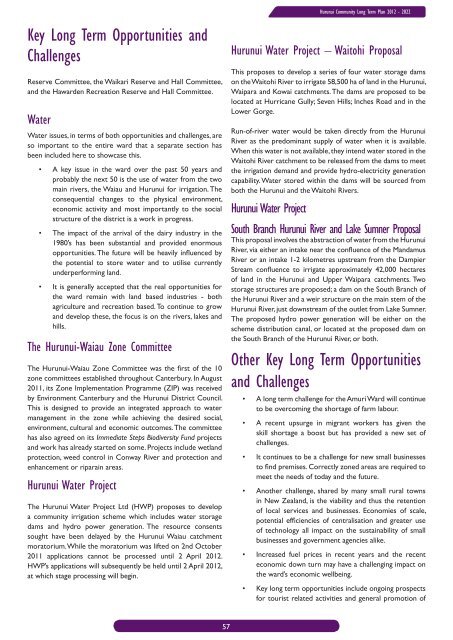Long Term Community Plan 2012-2022 - Hurunui District Council
Long Term Community Plan 2012-2022 - Hurunui District Council
Long Term Community Plan 2012-2022 - Hurunui District Council
You also want an ePaper? Increase the reach of your titles
YUMPU automatically turns print PDFs into web optimized ePapers that Google loves.
<strong>Hurunui</strong> <strong>Community</strong> <strong>Long</strong> <strong>Term</strong> <strong>Plan</strong> <strong>2012</strong> - <strong>2022</strong><br />
Key <strong>Long</strong> <strong>Term</strong> Opportunities and<br />
Challenges<br />
Reserve Committee, the Waikari Reserve and Hall Committee,<br />
and the Hawarden Recreation Reserve and Hall Committee.<br />
Water<br />
Water issues, in terms of both opportunities and challenges, are<br />
so important to the entire ward that a separate section has<br />
been included here to showcase this.<br />
• A key issue in the ward over the past 50 years and<br />
probably the next 50 is the use of water from the two<br />
main rivers, the Waiau and <strong>Hurunui</strong> for irrigation. The<br />
consequential changes to the physical environment,<br />
economic activity and most importantly to the social<br />
structure of the district is a work in progress.<br />
• The impact of the arrival of the dairy industry in the<br />
1980’s has been substantial and provided enormous<br />
opportunities. The future will be heavily influenced by<br />
the potential to store water and to utilise currently<br />
underperforming land.<br />
• It is generally accepted that the real opportunities for<br />
the ward remain with land based industries - both<br />
agriculture and recreation based. To continue to grow<br />
and develop these, the focus is on the rivers, lakes and<br />
hills.<br />
The <strong>Hurunui</strong>-Waiau Zone Committee<br />
The <strong>Hurunui</strong>-Waiau Zone Committee was the first of the 10<br />
zone committees established throughout Canterbury. In August<br />
2011, its Zone Implementation Programme (ZIP) was received<br />
by Environment Canterbury and the <strong>Hurunui</strong> <strong>District</strong> <strong>Council</strong>.<br />
This is designed to provide an integrated approach to water<br />
management in the zone while achieving the desired social,<br />
environment, cultural and economic outcomes. The committee<br />
has also agreed on its Immediate Steps Biodiversity Fund projects<br />
and work has already started on some. Projects include wetland<br />
protection, weed control in Conway River and protection and<br />
enhancement or riparain areas.<br />
<strong>Hurunui</strong> Water Project<br />
The <strong>Hurunui</strong> Water Project Ltd (HWP) proposes to develop<br />
a community irrigation scheme which includes water storage<br />
dams and hydro power generation. The resource consents<br />
sought have been delayed by the <strong>Hurunui</strong> Waiau catchment<br />
moratorium. While the moratorium was lifted on 2nd October<br />
2011 applications cannot be processed until 2 April <strong>2012</strong>.<br />
HWP’s applications will subsequently be held until 2 April <strong>2012</strong>,<br />
at which stage processing will begin.<br />
<strong>Hurunui</strong> Water Project – Waitohi Proposal<br />
This proposes to develop a series of four water storage dams<br />
on the Waitohi River to irrigate 58,500 ha of land in the <strong>Hurunui</strong>,<br />
Waipara and Kowai catchments. The dams are proposed to be<br />
located at Hurricane Gully; Seven Hills; Inches Road and in the<br />
Lower Gorge.<br />
Run-of-river water would be taken directly from the <strong>Hurunui</strong><br />
River as the predominant supply of water when it is available.<br />
When this water is not available, they intend water stored in the<br />
Waitohi River catchment to be released from the dams to meet<br />
the irrigation demand and provide hydro-electricity generation<br />
capability. Water stored within the dams will be sourced from<br />
both the <strong>Hurunui</strong> and the Waitohi Rivers.<br />
<strong>Hurunui</strong> Water Project<br />
South Branch <strong>Hurunui</strong> River and Lake Sumner Proposal<br />
This proposal involves the abstraction of water from the <strong>Hurunui</strong><br />
River, via either an intake near the confluence of the Mandamus<br />
River or an intake 1-2 kilometres upstream from the Dampier<br />
Stream confluence to irrigate approximately 42,000 hectares<br />
of land in the <strong>Hurunui</strong> and Upper Waipara catchments. Two<br />
storage structures are proposed; a dam on the South Branch of<br />
the <strong>Hurunui</strong> River and a weir structure on the main stem of the<br />
<strong>Hurunui</strong> River, just downstream of the outlet from Lake Sumner.<br />
The proposed hydro power generation will be either on the<br />
scheme distribution canal, or located at the proposed dam on<br />
the South Branch of the <strong>Hurunui</strong> River, or both.<br />
Other Key <strong>Long</strong> <strong>Term</strong> Opportunities<br />
and Challenges<br />
• A long term challenge for the Amuri Ward will continue<br />
to be overcoming the shortage of farm labour.<br />
• A recent upsurge in migrant workers has given the<br />
skill shortage a boost but has provided a new set of<br />
challenges.<br />
• It continues to be a challenge for new small businesses<br />
to find premises. Correctly zoned areas are required to<br />
meet the needs of today and the future.<br />
• Another challenge, shared by many small rural towns<br />
in New Zealand, is the viability and thus the retention<br />
of local services and businesses. Economies of scale,<br />
potential efficiencies of centralisation and greater use<br />
of technology all impact on the sustainability of small<br />
businesses and government agencies alike.<br />
• Increased fuel prices in recent years and the recent<br />
economic down turn may have a challenging impact on<br />
the ward’s economic wellbeing.<br />
• Key long term opportunities include ongoing prospects<br />
for tourist related activities and general promotion of<br />
57

















